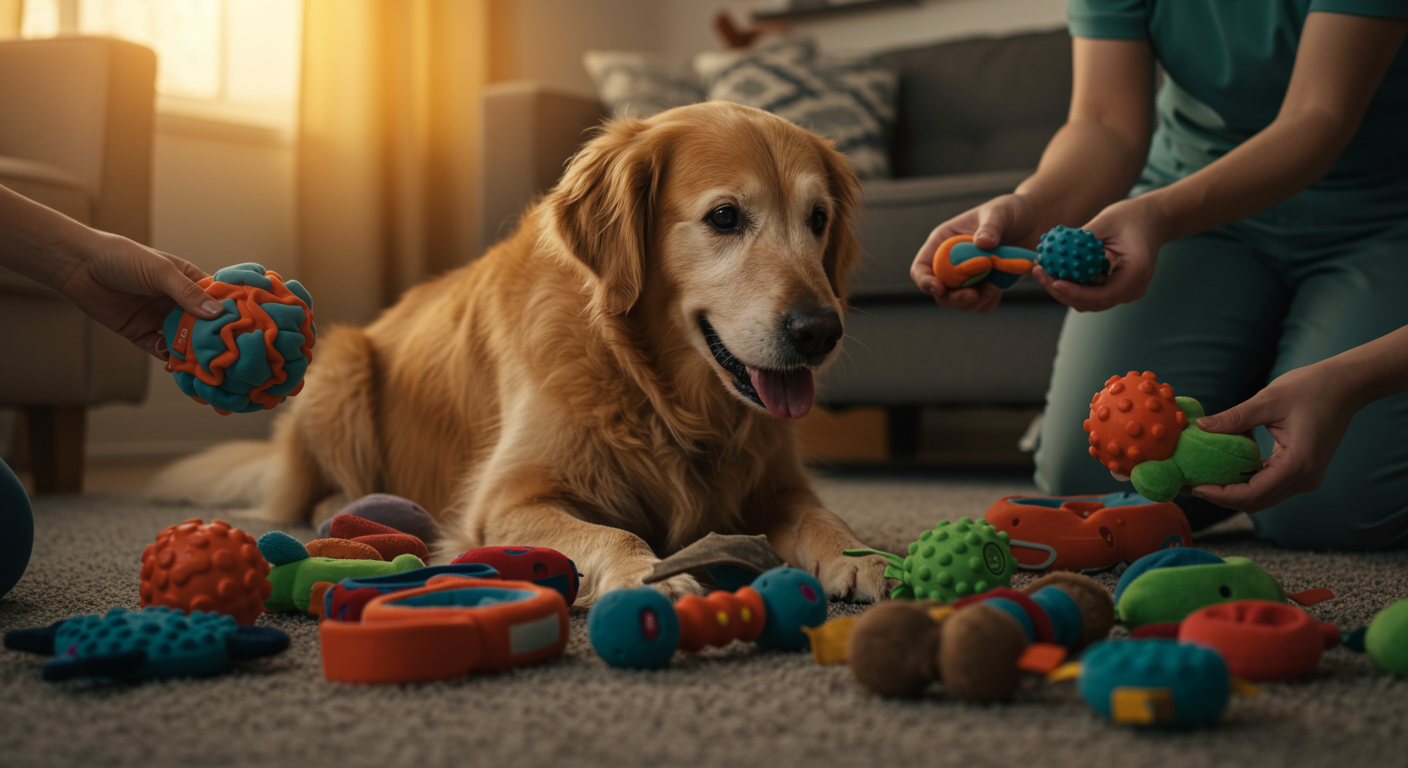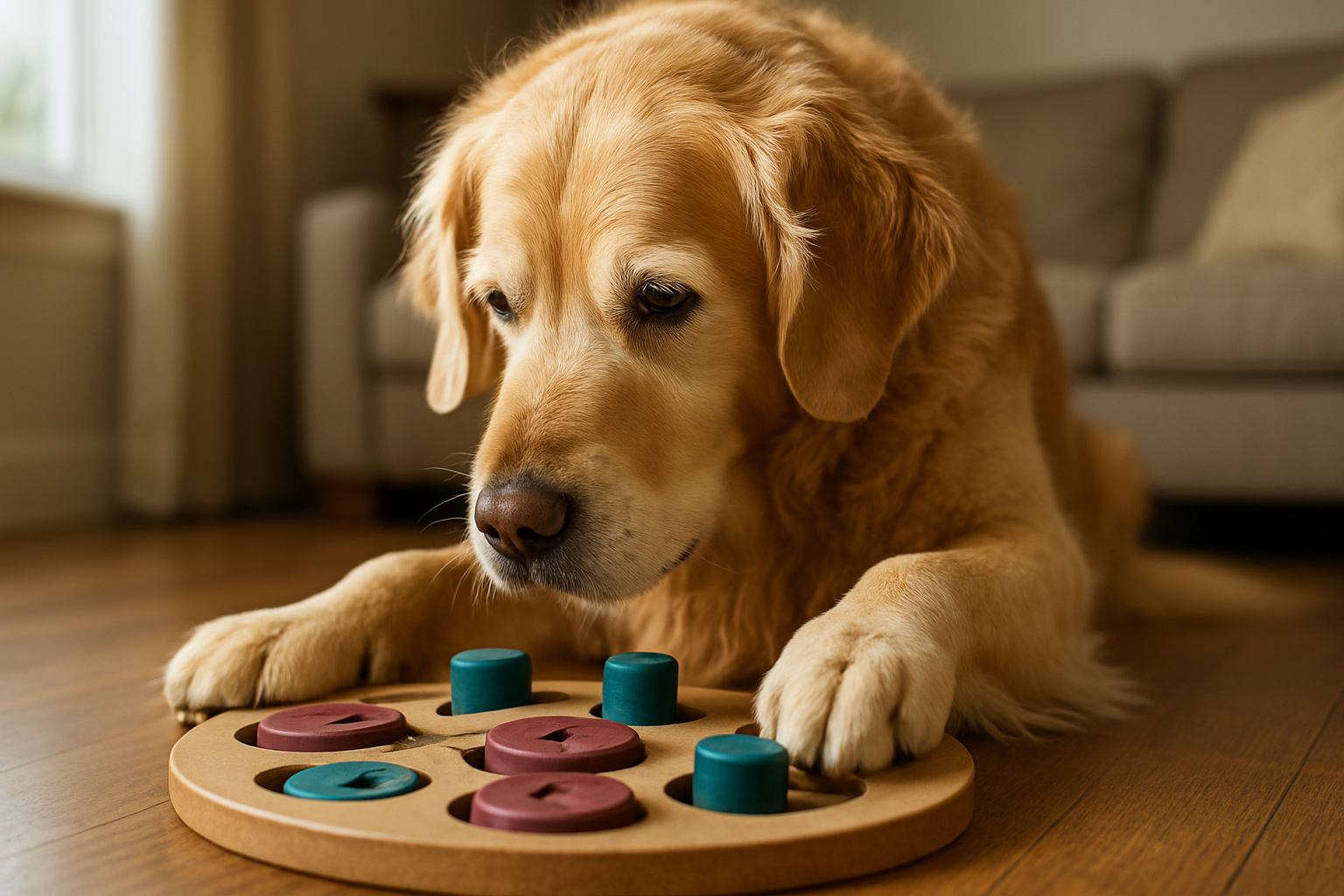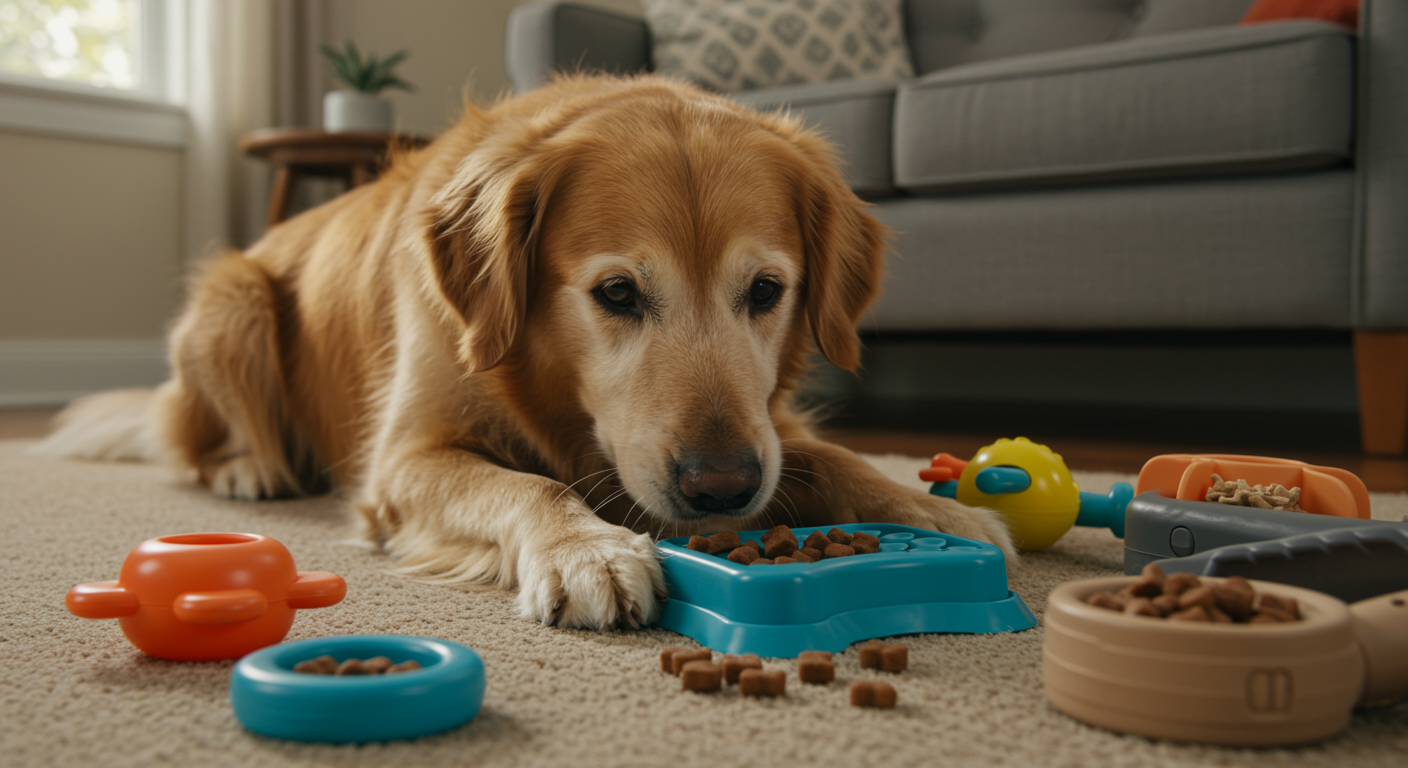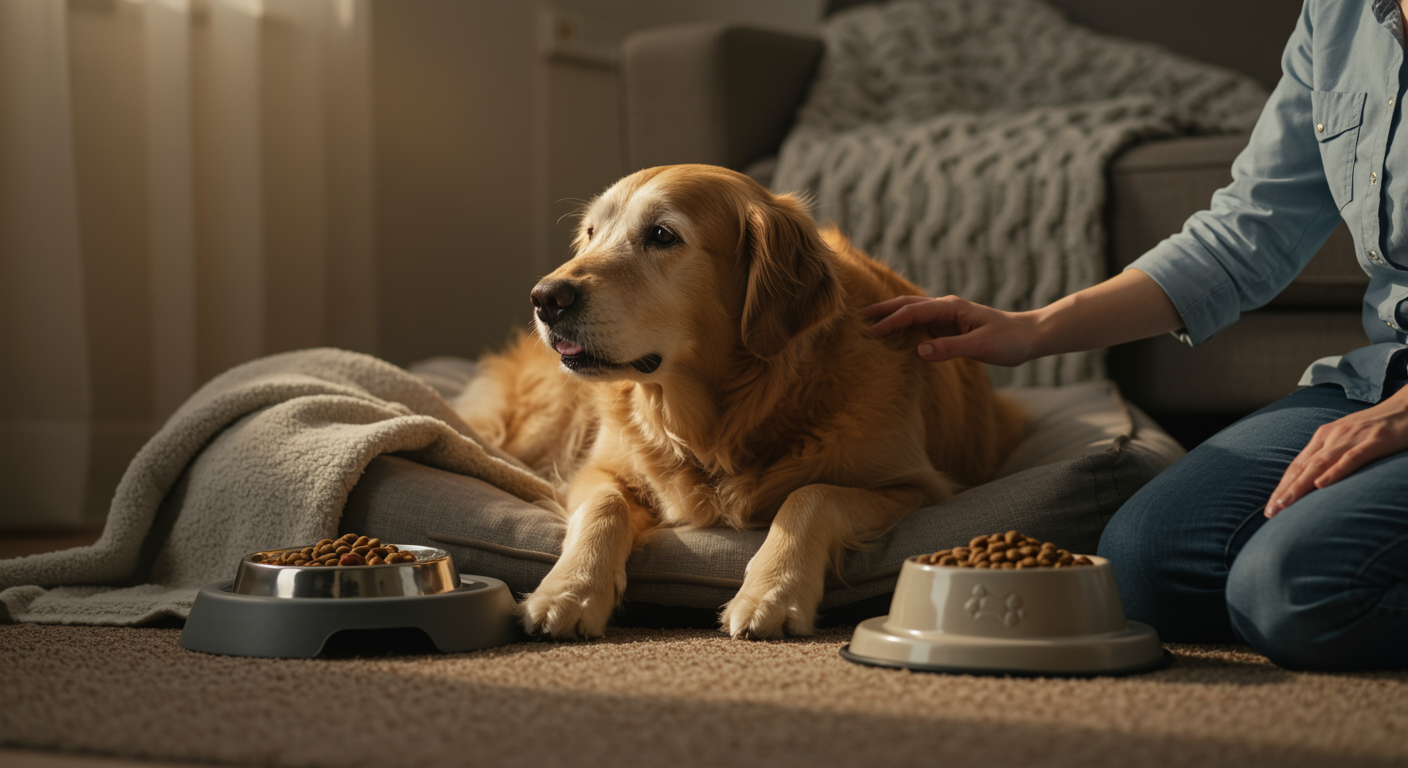Selecting appropriate toys for senior Golden Retrievers requires understanding their changing physical capabilities, cognitive needs, and play preferences that evolve with age. The right toys can provide essential mental stimulation, physical exercise, and emotional comfort while accommodating limitations such as reduced jaw strength, arthritis, or decreased energy levels that affect how senior dogs interact with their environment.
Senior Golden Retrievers benefit from toys that challenge their minds without overwhelming their bodies, provide comfort during rest periods, and support their natural instincts in age-appropriate ways. Understanding how to choose and rotate toys helps maintain engagement while ensuring safety and accessibility for aging companions.
Effective toy selection for senior dogs focuses on mental enrichment, gentle physical activity, and emotional support while considering factors such as size, texture, durability, and complexity that make toys both appealing and manageable for dogs with changing capabilities and preferences.
Understanding Senior Play and Stimulation Needs
Cognitive Stimulation Requirements
Mental Exercise Importance
Senior Golden Retrievers require ongoing mental stimulation to maintain cognitive function, prevent boredom, and support overall brain health as they age. Appropriate toys can provide this essential mental exercise while accommodating physical limitations.
Understanding that mental fatigue can be as satisfying as physical exercise helps families select toys that provide cognitive challenges without requiring extensive physical exertion that may be uncomfortable for senior dogs.
Interactive toys that require problem-solving, memory, or decision-making skills help keep senior minds active while providing engaging activities that can be adapted to individual capabilities and energy levels.
Cognitive Adaptation Considerations
Senior dogs experiencing cognitive changes may need toys that are simpler to understand and operate, with clear cause-and-effect relationships that don’t create frustration or confusion during play sessions.
Understanding cognitive limitations helps guide toy selection toward options that provide stimulation without overwhelming senior dogs who may have shorter attention spans or reduced problem-solving abilities.
Familiar toy types that build on previously learned skills may be more successful than completely novel toys that require extensive learning of new concepts or manipulation techniques.
Physical Capability Adaptations
Joint Comfort and Mobility
Arthritis and joint stiffness common in senior Golden Retrievers require toy selection that accommodates reduced mobility, limited flexibility, and potential pain that affects how dogs can interact with playthings.
Understanding mobility limitations helps families choose toys that can be enjoyed from comfortable positions without requiring extensive movement, jumping, or strenuous physical manipulation.
Lightweight toys that are easy to carry and manipulate help senior dogs maintain play engagement while respecting joint limitations and energy conservation needs.
Jaw Strength and Dental Considerations
Reduced jaw strength and dental issues common in senior dogs affect their ability to manipulate hard toys, requiring softer alternatives that remain engaging without causing discomfort or dental damage.
Understanding dental limitations helps guide selection toward toys with appropriate textures that provide satisfying interaction without placing excessive stress on potentially sensitive teeth or gums.
Size considerations become important for senior dogs who may have lost teeth or developed jaw sensitivity that affects their ability to grasp and manipulate toys effectively.
Types of Stimulating Toys for Senior Dogs
Puzzle and Interactive Toys
Food-Dispensing Puzzles
Food puzzle toys provide excellent mental stimulation while making mealtime more engaging and extending eating duration for better digestion. These toys should be easy enough for senior dogs to operate successfully while still providing cognitive challenge.
Understanding puzzle complexity helps families select options that provide appropriate difficulty levels without creating frustration that could discourage interaction or cause anxiety about food access.
Adjustable difficulty puzzles allow for customization based on individual capabilities and can be modified as cognitive or physical abilities change over time.
Treat-Hiding Games
Interactive toys that hide treats in various compartments or require specific actions to access rewards provide mental stimulation while satisfying natural foraging instincts in age-appropriate ways.
Understanding foraging needs helps families provide opportunities for natural behaviors while ensuring that treat-hiding toys remain accessible and manageable for senior dogs with potential mobility limitations.
Variety in treat-hiding options helps maintain interest while preventing habituation that could reduce the cognitive benefits of interactive play.
Comfort and Emotional Support Toys
Soft Companion Toys
Plush toys can provide emotional comfort for senior Golden Retrievers, particularly those experiencing anxiety, cognitive changes, or increased need for security and reassurance.
Understanding emotional needs helps families select companion toys that provide comfort without being so large or complex that they become difficult to manage or transport.
Washable comfort toys help maintain hygiene while ensuring that emotional support items remain clean and pleasant for regular use and cuddling.
Calming and Anxiety-Relief Options
Toys designed specifically for anxiety relief, such as those with calming scents or weighted elements, can provide comfort during stressful periods or help senior dogs relax during rest times.
Understanding anxiety management through toys helps families provide additional support tools that complement other stress-reduction strategies while offering comfort during challenging times.
Texture-based comfort toys that provide tactile satisfaction through soft fabrics, different materials, or gentle stimulation can help reduce anxiety while providing pleasant sensory experiences.
Senior Dog Toy Selection Guide
| Toy Category | Benefits | Key Features | Safety Considerations | Age Adaptations |
|---|---|---|---|---|
| Puzzle Feeders | Mental stimulation, slower eating | Adjustable difficulty, easy cleaning | Avoid small parts, ensure food-safe materials | Simpler mechanisms, larger openings |
| Soft Comfort Toys | Emotional support, companionship | Washable, appropriate size | Check for loose parts, avoid toxic stuffing | Lighter weight, easy to carry |
| Chew Toys | Dental health, jaw exercise | Senior-appropriate hardness | Monitor for wear, replace when needed | Softer materials, ergonomic shapes |
| Interactive Balls | Gentle exercise, engagement | Lightweight, textured surfaces | Size appropriate to prevent choking | Slower-moving, easier to catch |
| Sensory Toys | Stimulation, exploration | Varied textures, sounds, scents | Non-toxic materials, appropriate volume | Enhanced sensory features for impaired senses |
| Treat Dispensers | Motivation, reward-based play | Easy operation, adjustable difficulty | Easy to clean, appropriate treat size | Larger openings, simpler mechanisms |
Mental Stimulation Through Interactive Play
Problem-Solving Activities
Cognitive Challenge Toys
Toys that require sequential actions, memory, or planning provide excellent cognitive exercise while being adaptable to individual senior dog capabilities and learning speeds.
Understanding cognitive exercise helps families select toys that challenge thinking skills without creating frustration or stress that could discourage engagement with mental stimulation activities.
Progressive difficulty options allow for gradual challenge increases as dogs master simpler versions, maintaining interest while building confidence through successful problem-solving experiences.
Memory and Recognition Games
Toys that incorporate memory elements, such as hiding treats in specific locations or requiring recognition of patterns, help maintain cognitive function while providing engaging activities.
Understanding memory support helps families choose activities that exercise recall abilities while accommodating any cognitive changes that may affect learning or retention.
Simple memory games adapted for senior capabilities can provide meaningful cognitive exercise without overwhelming dogs who may have attention span or processing limitations.
Sensory Stimulation Options
Texture and Touch Toys
Toys with varied textures provide sensory stimulation that can be particularly valuable for senior dogs experiencing changes in vision or hearing that make other sensory inputs more important.
Understanding sensory needs helps families select toys that provide appropriate tactile stimulation while ensuring that textures are pleasant and non-irritating for potentially sensitive senior skin.
Rotating textural experiences helps maintain interest while providing variety in sensory stimulation that supports overall well-being and environmental engagement.
Sound and Movement Features
Gentle sound-producing toys can provide auditory stimulation while being appropriate for senior dogs who may be more sensitive to loud or startling noises than younger dogs.
Understanding sound sensitivity helps families choose toys with appropriate volume levels and pleasant sounds that stimulate without causing anxiety or discomfort.
Movement-based toys that respond to gentle interaction can provide visual and tactile stimulation while being manageable for dogs with reduced energy or mobility limitations.
Safety Considerations for Senior Dog Toys
Age-Appropriate Material Selection
Durability and Wear Monitoring
Senior dog toys should be durable enough to withstand regular use while being monitored for wear that could create safety hazards such as loose parts or sharp edges.
Understanding wear patterns helps families identify when toys need replacement while ensuring that play items remain safe throughout their useful life.
Regular inspection schedules help maintain toy safety while preventing accidents that could result from deteriorated or damaged play items.
Non-Toxic and Digestible Materials
Toy materials should be non-toxic and safe for senior dogs who may be more sensitive to chemicals or have compromised immune systems that make them more vulnerable to toxic exposures.
Understanding material safety helps families select toys made from appropriate substances while avoiding items that could cause health problems if ingested or extensively mouthed.
Natural materials or certified safe synthetic options provide peace of mind while ensuring that play activities don’t inadvertently expose senior dogs to harmful substances.
Size and Accessibility Considerations
Appropriate Sizing
Toys should be sized appropriately for senior Golden Retrievers, avoiding items that are too small and could pose choking hazards or too large to be manageable with potentially reduced jaw strength.
Understanding size requirements helps families select toys that are safe and manageable while providing appropriate challenge and engagement for individual dogs.
Size considerations should account for any changes in mouth size or jaw capability that may have occurred due to dental issues or age-related changes in facial structure.
Easy Manipulation Features
Toys should be designed for easy grasping and manipulation by senior dogs who may have reduced dexterity or strength in their jaws and paws.
Understanding manipulation needs helps families choose toys with features such as handles, textured grips, or ergonomic designs that make interaction easier and more comfortable.
Accessibility features that accommodate potential vision or coordination changes help ensure that toys remain usable and enjoyable throughout the aging process.
Toy Rotation and Engagement Strategies
Maintaining Interest and Novelty
Strategic Toy Rotation
Rotating toys regularly helps maintain interest and prevent boredom while making a smaller collection of toys seem more varied and engaging over time.
Understanding rotation benefits helps families develop systems that keep toys fresh and interesting while managing storage and ensuring that all toys receive appropriate use and maintenance.
Scheduled rotation helps ensure that cognitive stimulation remains varied while preventing over-familiarity that could reduce the mental exercise benefits of interactive play.
Seasonal and Activity Adaptations
Adapting toy selection based on seasonal changes, energy levels, or health fluctuations helps ensure that play options remain appropriate and engaging throughout various circumstances.
Understanding adaptation needs helps families maintain consistent play opportunities while respecting changing capabilities or preferences that may occur with health changes or environmental factors.
Flexible toy selection allows for customization based on daily energy levels, comfort status, or specific needs that may vary from day to day in senior dogs.
Integration with Daily Routines
Mealtime Enhancement
Incorporating puzzle feeders and treat-dispensing toys into regular feeding routines provides mental stimulation while supporting digestive health through slower eating.
Understanding mealtime integration helps families make nutrition more engaging while providing cognitive exercise that becomes part of regular daily care routines.
Food-motivated play helps ensure regular engagement with mental stimulation while supporting nutritional goals and healthy eating patterns.
Rest and Comfort Integration
Providing comfort toys during rest periods helps support emotional well-being while offering gentle stimulation that doesn’t interfere with necessary recovery time.
Understanding rest integration helps families balance stimulation needs with recovery requirements while ensuring that toys support rather than interfere with adequate rest.
Comfort-focused play options provide emotional support during times when physical activity may be limited by health conditions or energy levels.
Therapeutic and Health-Supporting Toys
Physical Therapy Integration
Gentle Exercise Promotion
Toys that encourage gentle movement and stretching can support physical therapy goals while making therapeutic activities more enjoyable and engaging for senior dogs.
Understanding therapeutic benefits helps families select toys that complement professional physical therapy while providing ongoing support for mobility and strength maintenance.
Low-impact play options help maintain muscle tone and joint flexibility while respecting physical limitations and comfort requirements.
Balance and Coordination Support
Toys that encourage balance and coordination skills can help maintain these important abilities while providing engaging activities that support overall physical well-being.
Understanding balance support helps families choose activities that challenge stability skills appropriately while ensuring safety and preventing falls or injuries.
Progressive balance challenges can help maintain confidence while supporting physical skills that contribute to overall mobility and independence.
Cognitive Health Support
Memory and Learning Enhancement
Toys that provide memory challenges or learning opportunities help support cognitive health while providing engaging activities that can be adapted to individual capabilities and learning speeds.
Understanding cognitive support helps families select toys that provide appropriate mental exercise while accommodating any cognitive changes that may affect learning or memory retention.
Consistent cognitive challenges through appropriate toys help maintain mental sharpness while providing enjoyable activities that can be integrated into daily routines.
Long-Term Toy Management
Adaptation for Changing Needs
Health-Based Modifications
As senior Golden Retrievers’ health conditions evolve, toy selection may need adjustment to accommodate new limitations or changing capabilities that affect play preferences and abilities.
Understanding health adaptations helps families modify toy choices based on veterinary recommendations while maintaining engagement and stimulation appropriate for current conditions.
Regular assessment of toy appropriateness helps ensure that play options continue to provide benefits while remaining safe and accessible as dogs age.
Quality of Life Enhancement
Play as Enrichment
Appropriate toy selection contributes significantly to overall quality of life for senior Golden Retrievers by providing mental stimulation, emotional comfort, and gentle physical activity that supports well-being.
Understanding enrichment benefits helps families appreciate the importance of thoughtful toy selection while recognizing play as an essential component of comprehensive senior dog care.
Investment in appropriate toys demonstrates commitment to maintaining engagement and happiness throughout the senior years while supporting physical and cognitive health.
Bonding and Interaction
Interactive toys that involve family participation help strengthen bonds while providing shared activities that enhance relationships between senior dogs and their human companions.
Understanding bonding benefits helps families choose toys that create positive interaction opportunities while supporting emotional connections that remain important throughout aging.
Shared play experiences provide mutual enjoyment while creating positive memories and maintaining the special relationships that define the human-dog bond during the golden years.
Selecting appropriate toys for senior Golden Retrievers requires understanding their changing needs while choosing items that provide mental stimulation, physical comfort, and emotional support. Through careful selection, rotation, and adaptation, families can help their senior companions remain engaged, stimulated, and happy throughout their golden years.
Success in toy selection comes from recognizing individual preferences and limitations while providing variety that maintains interest and supports overall well-being. With thoughtful attention to safety, appropriateness, and engagement, toys can significantly contribute to the quality of life and happiness of senior Golden Retrievers.
The investment in appropriate toys demonstrates the commitment to comprehensive senior dog care while ensuring that play and stimulation continue to enrich daily life and support physical and cognitive health throughout the aging process.

Rafael Souza is a digital marketing strategist and lifelong dog enthusiast. Passionate about Golden Retrievers, he shares practical, research-based tips to help owners provide healthier and happier lives for their furry companions.






1 thought on “Appropriate Toys to Stimulate Senior Golden Retrievers”